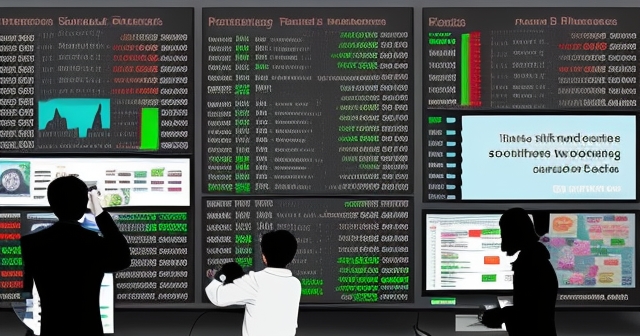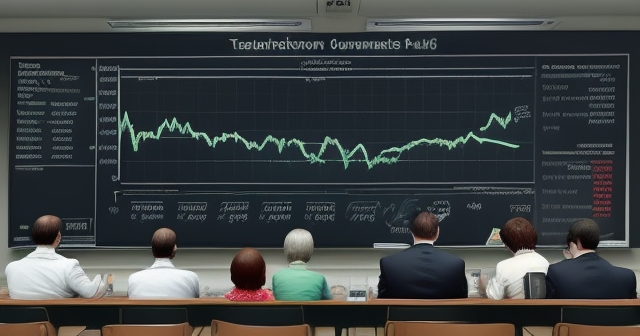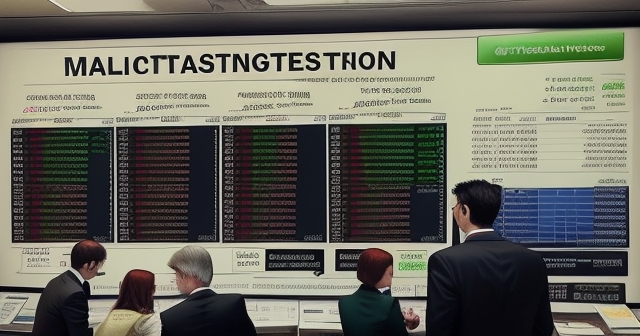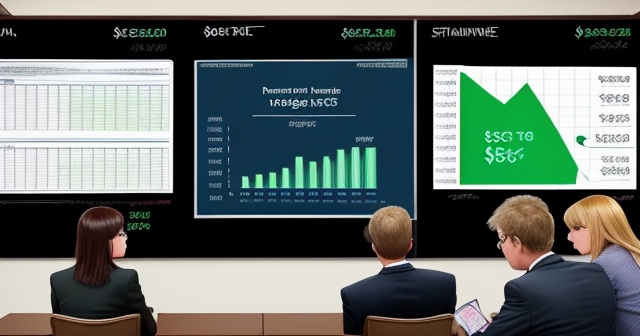
US Inflation Forecast: What to Expect in 2025
Table of Contents
ToggleUnderstanding the Complex Landscape of the US Inflation Forecast
The path of inflation in the United States is a topic of intense scrutiny, impacting everything from household budgets to the Federal Reserve’s critical monetary policy decisions. As investors and market participants, comprehending the forces at play, dissecting the latest data, and evaluating expert projections is paramount. Let’s embark on a detailed exploration of the current US inflation landscape, analyzing recent trends, economist forecasts, consumer sentiment, and the underlying factors that could shape price dynamics in the coming months and years.

To understand where inflation might be heading, we must first grasp where it stands today. The primary measure we focus on is the Consumer Price Index (CPI), published monthly by the U.S. Bureau of Labor Statistics (BLS). Think of the CPI as a vast basket of goods and services that represents what typical urban consumers purchase. Its movement reflects changes in the cost of living.
The most recent data provides a nuanced picture. In December 2024, the annual US inflation rate, measured by the year-over-year (YoY) change in the CPI, registered 2.9%. This marked the third consecutive month that the headline CPI rate increased, aligning closely with market expectations. What drove this uptick? A significant factor was the base effect from the previous year, particularly concerning energy prices. When comparing current prices to a period last year where energy costs were relatively low, the current year’s percentage change can appear higher even if prices haven’t dramatically surged recently. This is a crucial concept: base effects can sometimes temporarily distort the perceived trend of inflation.
- Monthly inflation rates can vary significantly based on external factors.
- Gas prices often play a decisive role in influencing CPI changes.
- Consumers may feel the immediate impact of inflation in their daily purchases.
Looking at the monthly data provides another layer of insight. The CPI increased by 0.4% in December 2024 compared to November 2024. This month-over-month (MoM) gain was the largest since March of the previous year and exceeded forecasts, which generally anticipated a 0.3% rise. This stronger monthly pace was notably driven by energy prices, specifically gasoline. This tells us that while the annual rate might be influenced by past comparisons, recent price movements, particularly in volatile categories like energy, continue to contribute to inflationary pressures on a month-to-month basis.
The Latest Inflation Data: A Deep Dive into CPI and Core CPI
While headline CPI captures the overall change in consumer prices, economists and policymakers often pay close attention to Core CPI. This metric excludes the more volatile components of food and energy. The rationale is that food and energy prices can fluctuate wildly due to factors like weather events, geopolitical issues, or supply disruptions that are often temporary. By stripping these out, Core CPI aims to provide a clearer signal of underlying, persistent inflation trends in the economy.
In December 2024, the Core CPI showed a slight deceleration on a year-over-year basis, slowing to 3.2% from 3.3% in November 2024. On a monthly basis, Core CPI rose by a more modest 0.3%. This divergence between the headline CPI’s acceleration (driven by energy) and the Core CPI’s slight moderation (YoY) suggests that while external, volatile factors continue to exert pressure, the pace of inflation in core goods and services might be cooling, albeit slowly. This signal is particularly important for the Federal Reserve as they assess whether inflationary pressures are becoming entrenched.

Understanding both headline and core measures is essential. Headline CPI is what consumers experience daily at the gas pump or grocery store, shaping sentiment. Core CPI is what many analysts use to gauge the underlying inflationary pulse of the economy, influencing longer-term forecasts and policy expectations. The recent data shows a complex picture: some components are accelerating, others are moderating, and base effects continue to play a role.
| Month | Headline CPI | Core CPI |
|---|---|---|
| December 2024 | 2.9% | 3.2% |
| November 2024 | 2.7% | 3.3% |
Economist Forecasts: Reading the Tea Leaves with Morgan Stanley and Goldman Sachs
Beyond the latest data, what do the experts predict for the future of US inflation? Economist forecasts are crucial inputs for businesses and investors alike, offering insights into potential future scenarios. We look to institutions with deep research capabilities, like Morgan Stanley and Goldman Sachs, to understand the consensus and notable divergences in projections.
Economic models provide a starting point. For instance, econometric models from Trading Economics project the US Inflation Rate (presumably CPI YoY) to trend around 2.40% in 2026 and 2.30% in 2027. These long-term projections suggest a gradual return towards the Federal Reserve’s 2% target, but the path is far from certain. For the nearer term, Trading Economics forecasts the Inflation Rate to be 2.90% by the end of the current quarter (which would likely refer to Q1 2025 based on the Dec 2024 data context), implying inflation could remain sticky at recent levels before potentially declining later.
- Analyst predictions often rely on sophisticated economic models.
- Adjustments in projections indicate responsiveness to market changes.
- Close attention to geopolitical changes is essential for accurate forecasts.
However, recent analysis from major investment banks has introduced new factors into the equation, leading to upward revisions in some forecasts, particularly for 2025. Economists at Morgan Stanley, for example, have predicted higher inflation in 2025 than they previously expected. They now foresee 2025 overall inflation rising to 2.5% (up from a prior forecast of 2.3%) and core inflation increasing to 2.7% (up from 2.5%). Similarly, analysts at Goldman Sachs have also raised their projections. They estimate that core PCE inflation (the Fed’s preferred gauge, which tends to run slightly lower than Core CPI) could rise to 3% this year with tariffs, versus a significantly lower 2.1% without them.

These upward revisions from prominent firms like Morgan Stanley and Goldman Sachs highlight a critical emerging risk factor: the potential impact of trade policy, specifically tariffs.
The Tariff Question: Why Trade Policy Looms Large in Future Projections
Tariffs are taxes imposed on imported goods. While their primary goal is often to protect domestic industries or exert geopolitical pressure, they have a direct impact on prices. When a tariff is imposed, the cost of the imported good increases for the domestic buyer (often businesses that use these imports as inputs or retailers selling foreign goods).
- Increased Input Costs: Many US businesses rely on imported components, raw materials, or finished goods. Tariffs on these imports directly raise the cost of production or acquisition for these businesses.
- Reduced Competition: Tariffs make imported goods more expensive, reducing their price competitiveness relative to domestically produced alternatives. This can allow domestic producers to raise their prices without losing market share.
- Supply Chain Adjustments: Businesses may shift sourcing away from tariffed countries, but finding alternatives can be costly, involve delays, or lead to higher prices from new suppliers.
- Retaliation: Other countries may impose retaliatory tariffs on US exports, potentially disrupting export markets and impacting the profitability of US businesses, though the direct inflationary impact is less clear.
The analysis from firms like Goldman Sachs underscores the magnitude of this potential effect, suggesting tariffs could add nearly a full percentage point to core inflation (3% vs 2.1%). This is a significant difference and a key reason why forecasts for 2025 are being adjusted upwards. Businesses themselves are reporting similar concerns, noting rising input costs (which we also see reflected in Producer Price Index or PPI data) and anticipating higher inflation partly due to these trade policy uncertainties. The “tariff question” is no longer theoretical for economists; it’s a tangible risk factor being integrated into their models and predictions for future price levels.
Consumer Pulse: Insights from the NY Fed’s Survey of Expectations
While official data and expert forecasts provide one perspective, understanding how consumers themselves perceive future price changes is equally vital. Consumer inflation expectations are closely watched by the Federal Reserve because they can become self-fulfilling. If consumers expect prices to rise significantly, they might demand higher wages, pull forward purchases, or adjust their spending habits, all of which can feed back into actual inflation.
The Federal Reserve Bank of New York (NY Fed) conducts a monthly Survey of Consumer Expectations (SCE) that offers valuable insights into this crucial aspect of the inflation picture. The survey asks consumers about their expectations for inflation over different time horizons: one year, three years, and five years ahead.

The April 2025 NY Fed SCE results presented a somewhat mixed picture, highlighting diverging views depending on the time horizon:
- The median expectation for inflation one year ahead remained unchanged at a relatively high 3.6%. This suggests that consumers anticipate price pressures to persist at elevated levels in the near term.
- The median expectation for inflation three years ahead increased notably to 3.2%. This marked the highest reading for the 3-year horizon since July 2022, indicating that consumers are becoming more concerned about inflation remaining elevated for a longer period than previously thought.
- Conversely, the median expectation for inflation five years ahead decreased slightly to 2.7%. This suggests that while near and medium-term concerns exist, consumers still expect inflation to eventually settle closer to the Fed’s 2% target over a longer timeframe.
| Time Horizon | Median Inflation Expectation |
|---|---|
| One Year Ahead | 3.6% |
| Three Years Ahead | 3.2% |
| Five Years Ahead | 2.7% |
Comparing this to slightly earlier data, like the May 2024 NY Fed survey, also shows shifts. In May 2024, the 1-year expectation declined to 3.2% (from 3.3%), the 3-year was unchanged at 2.8%, and the 5-year increased to 3.0% (from 2.8%). The April 2025 data, particularly the jump in the 3-year expectation, signals a potential shift in how consumers view the persistence of inflation, moving from hoping for a quicker return to normal to anticipating a longer plateau above the Fed’s target.
These consumer expectations are more than just numbers; they represent the collective sentiment that can influence economic behavior and, by extension, actual inflation outcomes. The Fed watches these closely as a gauge of whether their communication and actions are effectively anchoring long-term inflation expectations near their target.
Diving Deeper into Consumer Expectations: Rent, Medical Care, and More
The NY Fed’s Survey of Consumer Expectations also provides granular detail on how consumers expect prices to change for specific categories of goods and services. This allows us to see which components are driving their overall inflation outlooks.
In the April 2025 NY Fed survey, specific year-ahead consumer price expectations showed significant anticipated increases in crucial categories:
- Medical care price expectations surged to 8.7%.
- College education cost expectations rose to a striking 9.1%.
- Rent price expectations remained stubbornly high at 9.0%.

These are substantial expected increases, far exceeding the overall inflation expectations and highlighting areas where consumers feel particularly vulnerable to rising costs. Expectations for other categories were more mixed or stable:
- Food price expectations decreased slightly to 5.1%, still elevated but perhaps showing some anticipated moderation compared to previous highs.
- Gas price expectations were stable at 3.5%, a reflection of the inherent volatility but maybe less concern about significant spikes at that specific moment compared to the recent past.
What do these specific expectations tell us? They indicate that consumers are acutely aware of cost pressures in essential, non-discretionary areas like healthcare, education, and housing (rent). These are often large components of household budgets, and persistent high expectations here can significantly impact consumer confidence and spending power. While food and energy grab headlines, the stickiness expected in services like medical care and rent is a significant concern for the inflation outlook and household financial well-being.
Combined with the overall expectations across different horizons, the category-specific data paints a picture of a consumer who, while perhaps hopeful for a return to lower inflation in the very long term, is bracing for continued significant price increases in key areas that affect their daily lives and future planning (like college tuition).
Business Side of Inflation: Input Costs, PPI, and Pricing Power
Inflation doesn’t just appear at the consumer level; it often originates earlier in the supply chain. Businesses face their own set of cost pressures, which can eventually be passed on to consumers. This is where data like the Producer Price Index (PPI) becomes relevant. PPI measures the average change over time in the selling prices received by domestic producers for their output. It can serve as a leading indicator for consumer inflation.
Businesses are currently reporting rising input costs. These are the costs associated with the raw materials, components, labor, and energy needed to produce goods and services. As we’ve discussed, tariffs are a significant contributor to these rising input costs, particularly for firms reliant on imported goods. Higher PPI figures or business surveys indicating increased cost burdens signal that companies are facing pressure on their profit margins unless they can raise their selling prices.
| Cost Type | Impact on Prices |
|---|---|
| Raw Materials | Potentially raises prices due to increased sourcing costs. |
| Labor Costs | Higher wages lead to increased service pricing. |
| Tariffs | Increased input costs from imported goods, raising final prices. |
However, the ability of businesses to simply pass on these higher costs to consumers depends heavily on the demand environment. If consumer demand is strong, businesses have more pricing power – they can raise prices knowing consumers are willing and able to pay. If demand is slowing, however, businesses may be hesitant to raise prices too much for fear of losing customers or sales volume. They might absorb some of the increased costs, find efficiencies elsewhere, or seek cheaper suppliers, rather than risking a significant price hike.
Demand Dynamics: The Role of Retail Sales and Consumer Sentiment
This brings us to the crucial interplay between costs and demand. While businesses face rising input costs and potentially anticipate higher inflation (partly due to tariffs), there are counteracting forces that could temper the pass-through of these costs to consumer prices.
Forecasts for April retail sales, for example, have indicated a potential slowing in consumer spending. Retail sales data, published by the Commerce Department, provides a snapshot of consumer demand for goods. If retail sales are weakening, it suggests that consumers might be pulling back on discretionary spending, potentially due to accumulated inflationary pressure on their budgets, rising interest rates (making borrowing for purchases more expensive), or simply a shift in spending patterns.

Slowing retail sales directly impact businesses’ pricing power. If consumers are buying less, businesses are less able to raise prices. They might offer discounts, promotions, or simply hold prices steady to maintain sales volume. This dynamic could act as a significant brake on inflation, potentially limiting the full inflationary impact of tariffs and rising input costs, even if businesses wish they could pass them on.
Furthermore, the April 2025 NY Fed survey provided other signals related to consumer financial health and sentiment. Alongside higher 3-year inflation expectations, consumers reported a sharp deterioration in their household financial situations and outlooks. Expectations for income growth and the probability of finding a job also declined. This aligns with a picture of a consumer who might be feeling the pinch of past inflation and rising costs, becoming more cautious about their finances, and potentially less willing or able to absorb further price increases. This weakening consumer sentiment and potential pullback in demand is a key variable that could mitigate the upward price pressures originating from the supply side and trade policies.
Labor Market and Immigration: Potential Structural Drivers of Services Inflation
Beyond goods, services constitute a large and often sticky component of inflation. Prices for services like healthcare, education, transportation (ex-energy), and various personal services are heavily influenced by labor costs. Wages are a significant input cost for service providers.
The state of the labor market is therefore critical to the inflation outlook, particularly for services inflation. A tight labor market, characterized by low unemployment and strong demand for workers, typically leads to upward pressure on wages as companies compete for talent. These higher wage costs can then be passed on to consumers in the form of higher prices for services.
Some economists point to structural factors within the labor market that could contribute to persistent services inflation. For instance, tighter immigration restrictions are seen by some as potentially reducing the supply of labor in certain service sectors. A reduced labor pool relative to demand could sustain upward pressure on wages, even if overall economic growth moderates. If businesses face ongoing challenges in finding and retaining workers, leading to higher labor costs, this could keep services inflation elevated, acting as a counterweight to potential disinflationary forces in the goods sector.
Implications for Monetary Policy: The Fed’s Dilemma
All these threads—recent data, economist forecasts, consumer expectations, input costs, demand signals, and labor market dynamics—converge on the Federal Reserve. The Fed has a dual mandate: to achieve maximum employment and maintain stable prices (typically interpreted as 2% annual inflation over the longer run, using the PCE Price Index). When inflation is running above their 2% target, the Fed’s inclination is to maintain tighter monetary policy, primarily by keeping interest rates higher, to cool the economy and bring inflation down.
Persistent inflation above the Federal Reserve’s 2% target could significantly deter interest rate cuts. The market and many economists had anticipated rate cuts in 2024 or early 2025 as inflation appeared to be cooling. However, if new data points (like a re-acceleration in CPI), updated forecasts (citing risks like tariffs), or sticky consumer expectations suggest inflation will remain elevated for longer, the Fed will likely feel less urgency, or even hesitate, to lower rates. They prioritize price stability, and cutting rates prematurely while inflation remains a risk could jeopardize that goal.
| Concern | Potential Challenges |
|---|---|
| Inflation Above Target | Could hinder rate cuts and provoke tighter monetary measures. |
| Consumers’ Spending Behavior | Weak demand could limit businesses’ pricing power. |
| Trade Policy Implications | Tariffs could elevate overall inflation rates unexpectedly. |
The conflicting signals in the current environment – moderating core goods inflation vs. potential tariff impacts, strong input costs vs. signs of slowing demand, stable long-term consumer expectations vs. rising medium-term views – create a challenging environment for the Fed. They must weigh these disparate signals carefully to determine the appropriate path for monetary policy. Will potential supply-side shocks like tariffs outweigh demand-side moderation? Will persistent services inflation keep the overall rate elevated? The answers to these questions will shape the timing and magnitude of any future interest rate adjustments.
Navigating Uncertainty: Conflicting Signals in the Inflation Landscape
As we have seen, the current US inflation landscape is characterized by a set of conflicting signals, making precise forecasting particularly difficult. On one hand, we see signs that some of the earlier inflationary pressures may be easing. Core CPI YoY has slightly moderated, and there are indications that consumer demand might be slowing, which could limit businesses’ ability to push through price increases.
On the other hand, significant potential upward pressures remain. The explicit risk posed by potential tariffs, as highlighted by major forecasters like Morgan Stanley and Goldman Sachs, represents a considerable supply-side threat that could elevate input costs and consumer prices. Furthermore, sticky services inflation, potentially fueled by tight labor markets and wage pressures, continues to be a concern. Consumer expectations, while anchored longer-term, show worrying signs of rising in the medium term, which could influence behavior.
This environment of conflicting signals means there is a wider than usual range of potential outcomes for the US inflation forecast. Will the disinflationary forces eventually win out, bringing inflation steadily back towards 2%? Or will new pressures, particularly from trade policy and services stickiness, keep inflation elevated for longer? The interplay between these forces will determine the actual path.
For investors and policymakers, this uncertainty necessitates a cautious and flexible approach. Relying on a single forecast or focusing on just one data point would be misguided. Instead, it requires monitoring a broad range of indicators – official CPI/PPI data, detailed components, various economist forecasts, business surveys, and consumer confidence measures – to build a comprehensive picture and assess the evolving risks.
Conclusion: What Lies Ahead for US Inflation?
The US inflation forecast remains an intricate puzzle, influenced by a multitude of interconnected factors. We have explored the recent data showing a slight uptick in headline CPI driven by energy base effects, while Core CPI exhibits modest moderation. We have dissected economist forecasts, noting upward revisions for 2025 largely attributed to the potential impact of tariffs on input costs and final prices. We’ve analyzed consumer expectations, observing the divergence across different time horizons and significant anticipated price increases in essential categories like rent, medical care, and education.
Underlying these trends are fundamental economic forces: the battle between rising input costs for businesses (potentially exacerbated by tariffs and tight labor markets) and the constraints imposed by potentially slowing consumer demand. The ability of businesses to pass on costs hinges critically on the strength of consumer spending and overall economic momentum.
The trajectory of inflation holds significant implications for the Federal Reserve’s monetary policy decisions. Persistent inflation above their 2% target will likely reinforce a cautious stance, potentially delaying anticipated interest rate cuts. Conversely, clear signs of disinflationary pressures, coupled with a noticeable cooling in the labor market or consumer demand, could provide the Fed with the confidence to adjust rates.
For those navigating the financial markets, staying informed about the latest inflation data, understanding the nuances of core vs. headline measures, evaluating the impact of external factors like tariffs, and gauging the pulse of consumer and business sentiment are not merely academic exercises. These insights are essential for making informed investment decisions, managing risk, and adapting to the evolving economic landscape shaped by the forces of inflation.
us inflation forecastFAQ
Q:What is the current US inflation rate?
A:The current US inflation rate is 2.9% as of December 2024.
Q:How do tariffs affect inflation forecasts?
A:Tariffs can increase input costs for businesses, which may lead to higher consumer prices and is considered when forecasting inflation.
Q:What do consumers expect regarding future inflation?
A:Consumers expect inflation to remain elevated, anticipating a 3.6% rise one year ahead.
You may also like
Calendar
| 一 | 二 | 三 | 四 | 五 | 六 | 日 |
|---|---|---|---|---|---|---|
| 1 | 2 | 3 | 4 | 5 | 6 | 7 |
| 8 | 9 | 10 | 11 | 12 | 13 | 14 |
| 15 | 16 | 17 | 18 | 19 | 20 | 21 |
| 22 | 23 | 24 | 25 | 26 | 27 | 28 |
| 29 | 30 | 31 | ||||
發佈留言
很抱歉,必須登入網站才能發佈留言。